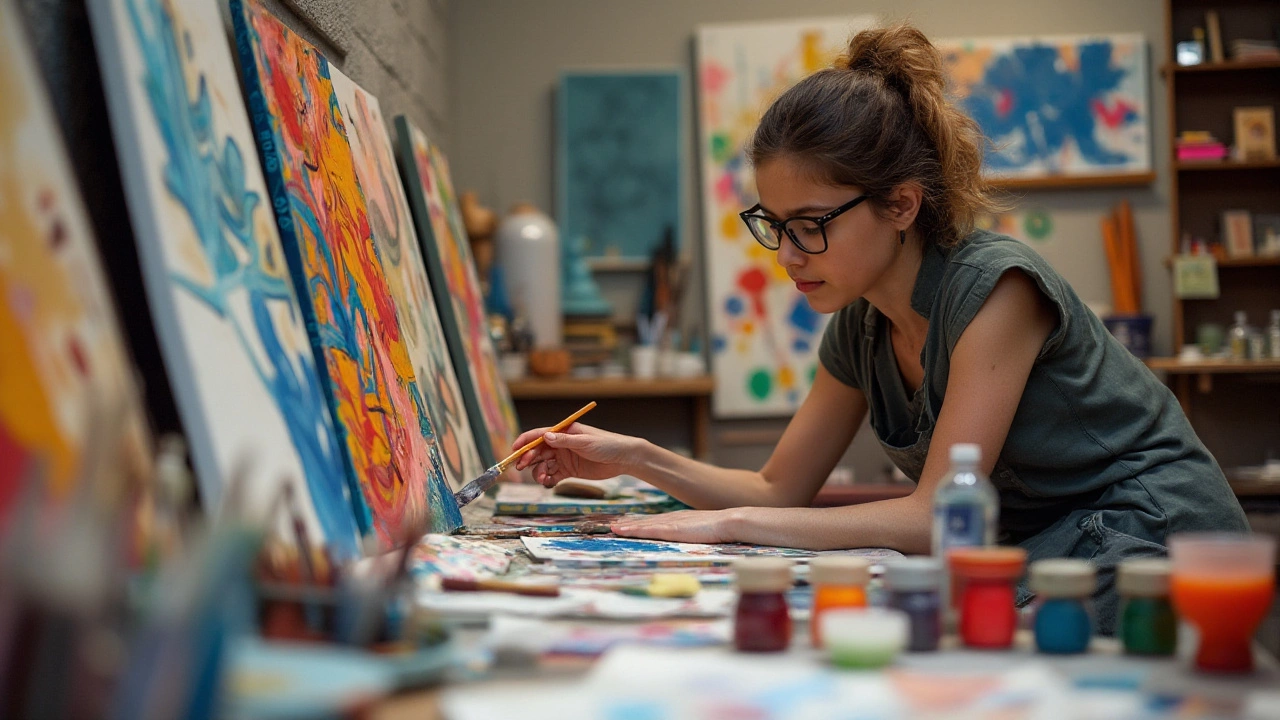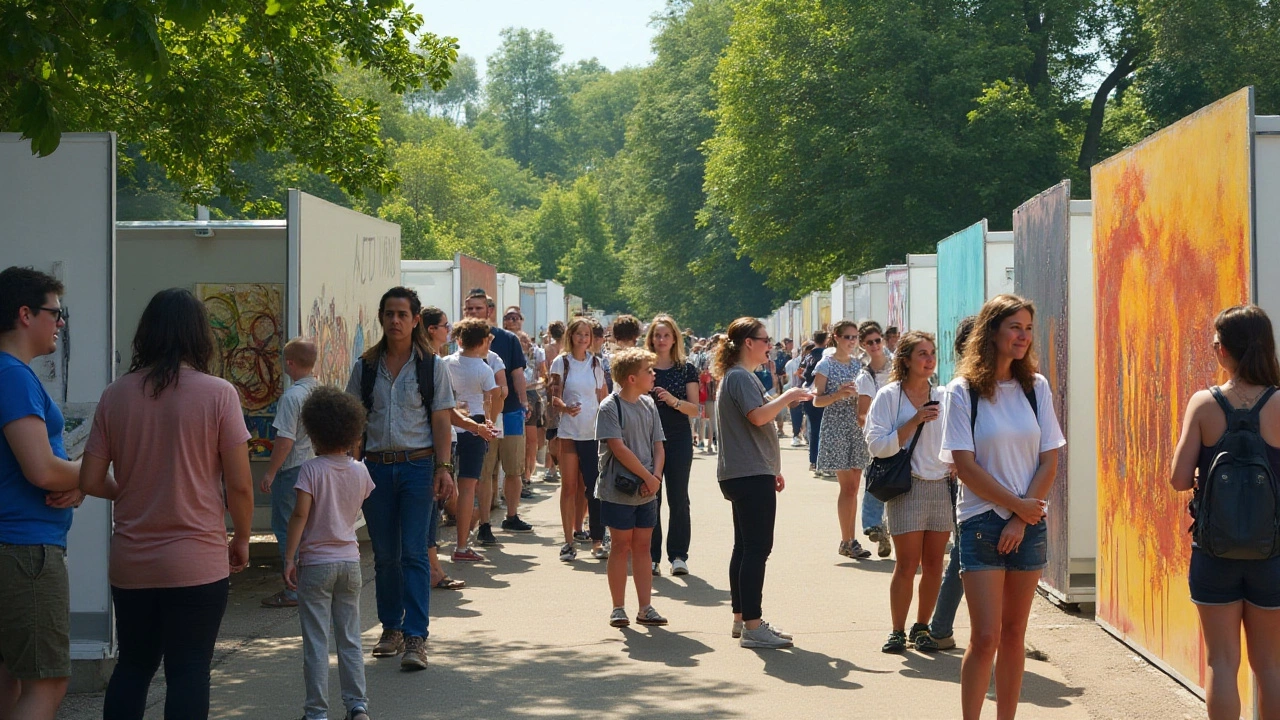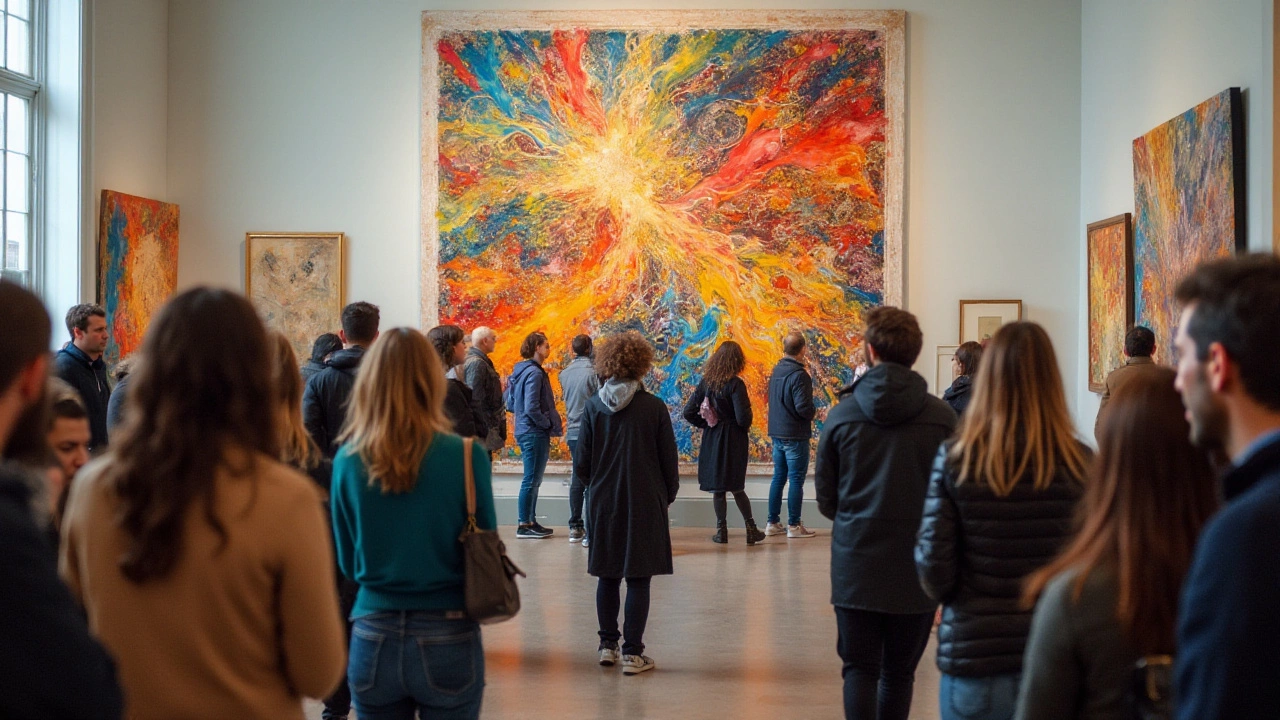Abstract art is a world where reality bends, forms shift, and rules are redefined to spark connection and stir emotion. It steps away from the known and ventures into an exploration of elements that define artistic freedom. Rooted in principles and yet boundless in its expression, abstract art often confuses the novice while offering a profound intrigue.
We explore the seven essential elements that form the backbone of abstract art, revealing how they are uniquely manipulated to create depth and evoke meaning beyond the visible. These elements—line, color, shape, form, texture, space, and value—are the silent storytellers in a canvas full of chaos and complexity. In this domain, each stroke is a narrative, each hue a feeling, and every form a thought manifesting itself through art.
- The Significance of Line and Color
- Exploring Shape and Form
- Delving into Texture and Space
- Understanding Value in Abstract Art
The Significance of Line and Color
In the realm of abstract art, the concepts of line and color stand as vital elements that provide both structure and expression. When examining a piece of abstract art, one might first be drawn to the boldness of its lines, whether they are sharp and jagged or smooth and flowing. Lines can evoke a range of emotions, often acting as conduits of energy and movement across the canvas. They can dictate the viewer’s journey through the artwork, guiding the eye from one part to another, highlighting areas of interest or underlining themes intended by the artist.
Consider the work of early abstract artists like Wassily Kandinsky, who profoundly understood the symbiotic relationship between line and music. Kandinsky often spoke of his paintings in musical terms, equating lines to rhythms and compositions that resonate with the viewer. As Kandinsky once noted, "Color is a power which directly influences the soul." Such insights reveal the deep impact of color intertwined with line, demonstrating that together they can create a narrative without need for tangible forms.
Colors in abstract art transcend traditional uses, breaking free from realistic representation for a more emotional impact. The choice of color palette can define the mood of an artwork, from vibrant and joyful to muted and reflective. Abstract artists like Mark Rothko used vast fields of color to evoke spirituality and profound emotional responses, with each hue chosen meticulously to affect the viewer's psyche. Studies have shown that humans can react physiologically to colors, with warm hues like red and orange increasing heart rates and cool colors like blue and green evoking calmness.
For those creating modern art, understanding the subtlety of how colors interact can add layers to their work. Artists often play with complementary colors or stark contrasts to present tension or harmony within a piece. The interaction of these colors with lines creates complex layers that can engage viewers, prompting deep contemplation or visceral reactions. By employing such techniques, an artist can turn a simple canvas into a dynamic expression of thought and emotion.
To truly grasp the structural impact of lines and the emotive potential of color, emerging artists can explore through experimentation within these realms. Consider creating pieces where you let lines dictate the flow and then allow color to fill those spaces—each choice both intentional and instinctive. As Piet Mondrian famously illustrated through his compositions, simple lines combined with primary colors can create works of surprising complexity and beauty. His approach underscores the idea that abstraction does not mean lack of form; it means a form that is not immediately recognizable.

Exploring Shape and Form
In the mystical realm of abstract art, shape and form are pivotal in crafting a visual dialogue between the artwork and the observer. These two elements operate as the architecture of an abstract piece, offering both chaos and structure, depending on the artist’s intent. The shape is typically defined as an enclosed space created through lines, color, and boundary definition, whereas form is about the depth or three-dimensional aspect of these spaces. In abstract art, shapes are often geometric or organic, creating a fascinating interplay that captures the viewer's imagination. It’s intriguing how a simple circle or square can take on emotional and symbolic meaning when placed in an abstract context, challenging our perception of reality and encouraging a fresh perspective.
Artists often exploit these elements to blur the line between the tangible and the imaginary. One can look at the works of figures like Wassily Kandinsky, who famously attributed emotional resonance to shapes. He suggested that the circle embodies the spirit, representing calm and enlightenment, whereas other shapes carry different emotional weights. The intention is not just to draw the eye but to engage the soul. This use of shape is also evident in the works of Joan Miró, whose abstract forms are rich with playful, dream-like symbolism. The ambiguity of shape can stir various interpretations, offering each viewer a unique experience based on their perception and emotions.
Form adds dimension to abstract art, taking the flat shapes and transforming them into a seemingly sculptural narrative. While some might think of it as a mere technicality, form has the potential to convey movement and emotions, capturing the abstraction's essence. When we talk about form in abstract art, it concerns not only the physical but also the conceptual depth that shapes take on. Some artists choose to exaggerate the concept of form, utilizing techniques such as overlapping or the use of varied textures to enhance the three-dimensional impact. In pieces where form takes precedence, an artwork can transcend mere visual pleasure and become an intellectual puzzle. Abstract sculptors like Henry Moore show how forms interact with space, creating fluidity and motion even within solid structures.
Shapes and forms are not just static images; they are dynamic entities that dance across the canvas. For an instructor or a learner examining modern art, it is essential to decipher how these components blend and juxtapose against each other. In a well-executed piece, the relationship between shape and form is harmonious, threads in a tapestry where the artist switches from harmony to contrast to evoke a narrative or an emotional response. This play on harmony and disruption is what gives abstract art its distinctive allure, engaging audiences and inviting them to ponder the deeper meanings behind the visuals.
A powerful aspect of working with shape and form is the freedom it provides. While traditional art often binds artists to follow realism, abstract art liberates them to distort, manipulate, and reinvent shapes and forms. An artwork like Kazimir Malevich's "Black Square" reminds us of this freedom. It breaks from tradition while inspiring endless interpretations and discussions on its meaning and significance. This radical approach resonates with the abstract art community worldwide, encouraging an embrace of innovation in art-making.
"Art should be something that liberates your soul, provokes the imagination and encourages people to go further." - Keith Haring
In sum, the exploration of shape and form in abstract art is not just a journey through aesthetics but an adventure into the mind's labyrinth. Like the rhythmic dance of notes in a symphony, these elements come together to create a piece that is never truly silent, always whispering the artist’s thoughts, dreams, and chaos into the world in an elegant, visual language.

Delving into Texture and Space
In the world of abstract art, texture and space are like the gestures and whispers of a silent symphony, each contributing to the tableau in ways that allure and captivate the viewer’s eye. Texture, the tactile quality of a surface, is not just about physical touch, but about the illusion and perception of touch that can elicit an emotional response, as a heartfelt poem would with its vivid imagery. An artist may layer paint thickly, producing a rugged landscape that projects from the canvas, practically begging to be touched. Alternatively, they may smooth each brushstroke to create an ethereal, almost transcendent quality that beckons you to contemplate the mysteries of the universe itself.
This duality in texture—one drawing us in with its tangible weight, the other subtly inviting with an illusory grace—enables artists to express a range of emotions and ideas. Yet texture is more than physical manipulation; it's about contradiction, duality, and the raw interplay between what's seen and what’s felt. Consider the works of Jackson Pollock, whose dribbles and splatters evoke chaos and vitality, rendering each canvas a battlefield of pigment and movement.
Space, the very realm that texture inhabits, offers a dimensional stage for such performances to unfold. Not merely a backdrop, space in abstract art becomes dynamic, engaging viewers in a spatial dialogue. It can be defined or infinite, crowded or expansive, altering perceptions and encouraging exploration beyond the immediate visual plane. When Kandinsky suggested that "form in itself, even if completely abstract... has its own inner sound," he acknowledged the role of space in inviting interpretation and interaction.
The relationship between texture and space is symbiotic; where texture has weight, space gives it context. Each mark on the canvas defines the boundaries of its surrounding voids, a dance of proximity and isolation. When a painting is relieved of representational constraints, space becomes both a literal and metaphoric frontier. In an abstract work, space might hint at narrative or exist as a pure element of design, a quiescent pause in the furious dance of forms and colors. Some painters, like Mark Rothko, use fields of color to construct a sense of floating atmospheres, where viewers might lose themselves in the enveloping hues and immeasurable depths.
Combining texture and space, abstract art offers infinite possibilities—pathways to worlds unseen, corridors filled with questions rather than answers. They are the language of these works, mysterious and wonderfully open-ended. As you stand before an abstract piece, it’s these very elements of texture and space that beckon you to enter, to engage in a personal conversation that’s as unique as the interplay of the art itself. Whether you're admiring a soaring cathedral of brushstrokes or a gentle dusting of pastel tones, the balance and imbalance of these elements become an exploration of the profound capabilities of human creativity.

Understanding Value in Abstract Art
In the expansive realm of abstract art, the concept of value takes on a fascinating role. Value, at its core, refers to the lightness or darkness of a hue, an element that is pivotal not just in representational art but particularly transformative in abstract works. Beyond merely articulating a visual gradient, value can shape the mood, emphasize focal points, and create a sense of depth and form. Artists wield value to direct the viewer's eye and evoke emotions without the reliance on explicit representational forms.
Intriguingly, value does not refer simply to the color itself but to the brightness or darkness of that color, whether it is a bold red or a tender pastel. In abstract compositions, a high contrast in value might amplify tension or energy, while a subtle variation could instill calmness or stillness. This manipulation of value allows artists to conjure an emotional spectrum within the confines of their canvas. Wassily Kandinsky, a herald of abstract expression, believed that color's form paired with its value could resonate like music, altering perception profoundly through these dual elements. He once stated, "Color is a power which directly influences the soul."
Notably, the dialogue of value with other elements like texture and form opens up vast avenues for exploration. When employed with texture, value can enhance tactile illusions, deepening the visual experience. It can create forms that suggest volume or mass, influencing how space within artwork is perceived by a viewer. Abstract artists often use value gradients to lead the viewer through a narrative, presenting a journey that might otherwise be simple lines and shapes in their exquisite abstraction. This interplay is critical for achieving the dynamic balance that defines many iconic pieces of abstract art.
In the context of spatial organization within an artwork, value plays a role as significant as perspective in traditional art forms. A sound understanding of value can allow an artist to forego realistic depiction while still maintaining harmony and rhythm. The absence or prominence of light and shadow through varied values can provide the dimension needed to guide the audience across a composition — a technique that becomes particularly evident in monochromatic artworks where hue becomes a supporting rather than leading element.
As viewers, deciphering value in abstract art invites us to engage on an instinctual level. Often, it isn't about what we see, but how we feel when we see it. Value breathes life into shapes and spaces that might otherwise lack introspective allure. It is the silent language behind expressive chaos, capable of compelling thought and stirring the unconscious. This sophisticated modulation of tone and contrast is a testament to the nuanced beauty of abstract art, offering a universal visual dialect that connects diverse audiences worldwide.

